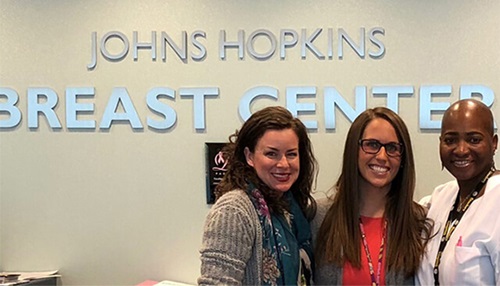New Breast Reconstruction Advances
You might be having a mastectomy because you have breast cancer or to prevent the disease if it runs in your family. If so, you may also be considering breast reconstruction to rebuild your breasts, which isn’t a one-size-fits-all procedure. Some techniques use artificial implants, some use your own tissue. Others use a combination of both.

It can be difficult sifting through the choices to figure out what will work best for you. But the most important thing to know is that there are options, says Michele Manahan, M.D., a professor of plastic and reconstructive surgery at Johns Hopkins Medicine. “Breast reconstruction is not one-size-fits-all. Now more than ever we have so many ways to restore your form and make you look and feel like yourself again.”
A New, Less Painful Breast Implant Procedure
Manahan and her colleagues perform a state-of-the art procedure called pre-pectoral breast reconstruction. It reduces pain and provides a speedier recovery compared with traditional reconstruction by placing implants or tissue expanders on top of the pectoral muscles. Since the muscles aren’t cut or stretched, you can return to your normal daily activities sooner. “Our patients are doing yoga and have full range of motion within the first month after the procedure,” Manahan says.
The pre-pectoral procedure is the most minimally invasive breast reconstruction option. Your doctor can perform a mastectomy by removing breast tissue through a small incision underneath the breast. Through this incision, a tissue expander can be placed on top of the muscle to create a breast mound. Later, your doctor can remove the expander through the same incision and insert an implant.
A Natural Alternative to Breast Implants
Although using implants lets you recover faster, not everyone likes the way they look or the prospect of needing future surgeries to replace them if they rupture. A natural alternative involves using fat and tissue from another area of your body to fill in your breasts.
In the past, doctors removed muscle, fat and skin from the abdominal wall, the back, the inner thighs or the buttocks and moved it to the chest to form breasts. This procedure was painful and had a long recovery. But now an updated technique lets you use your own tissue with less pain and faster healing. During this surgery, called a perforator flap procedure, your surgeon moves only skin, fat and tissue — not muscle — to your chest area. Not everyone is a candidate for this procedure, depending on anatomy and previous surgical history, but it’s a good option for some women.
Using your own tissue creates a more natural look. And you can also have a tummy tuck, thigh lift or buttock lift at the same time if you have tissue removed from those areas.
Traditional Breast Reconstruction
The majority of breast reconstruction procedures involve breast implants. In this traditional reconstruction procedure, saline or silicone implants are placed below the pectoral muscles, forcing them to stretch to accommodate the implants. “This method works for a good deal of people, but many women experience pain as well as decreased range of motion in the shoulder,” reports Manahan. “Over time, chest wall deformities from the implants can form as well.”
What to Consider Before Breast Reconstruction
There are several things you need to consider when reviewing reconstructive breast cancer options, says Manahan. What procedure is best for you depends on many factors, such as:
- Overall health
- Activity level
- What you do for a living
- Whether you want to have children after surgery
- If you have the extra tissue needed for a natural reconstruction
- How much post-surgery downtime you’re comfortable with
If you’re going to have a lumpectomy or mastectomy, consult with a plastic surgeon in addition to your breast surgeon. A plastic surgeon can provide guidance on the various breast reconstruction procedures and work in partnership with your breast surgeon to give you the look you want.
It’s okay to take your time to come to a decision, says Manahan. “You might not know if you want implants, or whether you want to use belly or thigh tissue, or if you’re going to need radiation. But you can still move forward with the mastectomy. We can insert a tissue expander to hold a breast-like form under your skin. Then, when you’re ready, we can remove the expander and reconstruct your breasts with either implants or your own tissue. What’s important is knowing there are many options for breast reconstruction, and consulting with your surgeon to find the best choice for you.”
Everyone and every body is different, reminds Manahan, and every patient has different preferences and goals. "We hope that the many choices we have to offer for breast reconstruction will allow us to tailor each reconstruction to each individual patient."
To learn more about postponing your breast reconstruction, read 7 Things You Might Not Know About Delayed Breast Reconstruction.
Reconstructive Surgery After Breast Cancer

This type of surgery requires not just a skilled and experienced surgeon but also a team of doctors and nurses who treat breast cancer. Johns Hopkins plastic and reconstructive surgeons specialize in complex breast reconstruction procedures and have successfully completed reconstructions for hundreds of women, restoring their self-image after cancer treatment.






